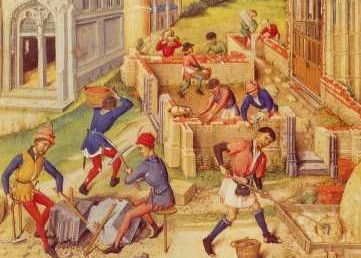Rondel (dagger)
|
|
A rondel (pronounced or ) or roundel was a type of stiff-bladed dagger in Europe in the late Middle Ages (from the 14th century onwards), used by a variety of people from merchants to knights. It was worn at the waist and might be used as a utility tool, or worn into battle or a jousting tournament as a side-arm. The blade was typically long and slim, measuring 12 inches (30 cm) or more; the whole dagger might be as long as 20 inches (50 cm). Rondel means round or circular; the dagger gets its name from its round (or similarly shaped, e.g. octagonal) hand guard and round or spherical pommel (knob on the end of the grip).
| This example has one sharpened edge and a sharp point. The grip would be made from wood or bone, and was often carved. |
| The guard and pommel are both discs or "rondels", from which the dagger gets its name. The steel blade is slim and stiff and best suited to a stabbing motion. It would most commonly have been as long as this in proportion to the grip, if not longer. |
The blade was stiff, made from steel, and the tang extended through the handle, which was cylindrical, normally carved wood or bone. In profile, the blade was usually diamond-shaped, lenticular, or triangular. These blades would have a sharpened point, and either one or both edges would also be sharpened. They were principally designed for use with a stabbing action, either underarm, or over arm with a reverse grip (think ice pick). They would also have been used for cutting. The long straight blade would not have lent itself to a slashing or sabre action. Rondels were ideal in battle for puncturing chainmail, and although they would not have been able to punch through plate armour, they could be forced between the joints in a suit of armour and helmets. This was often the only way in which a heavily armoured knight could be killed.
A few examples also exist of four-edged rondels, the blade having a cruciform profile. These blades would not have been suited for cutting, or use as a general utility tool; they would have been worn as a side-arm in battle. The rondels which have survived and found their way into museums and collections are usually those with fine craftsmanship and often ornate decoration. The blades may be engraved, the grips ornately carved, and the hand guards and pommels highly decorated.
 |
| Merchants wearing rondels |
| (Uncropped version) |
In this image, merchants and tradesmen can be seen wearing rondels at their waists (bottom left). The scene is from a miniature by Girat de Roussillon depicting the construction of twelve churches in France c. 1448. Before the 1400s, daggers were actually a peasant's weapon. However, in the 15th century they became the standard side-arm for knights, and would have been carried into battles such as the Battle of Agincourt in 1415. They were a knight's backup weapon to be used in hand to hand fighting, and as such one of their last lines of defence. Since they were able to penetrate a suit of armour (at the joints, or through the visor of the helmet), rondels could be used to force an unseated or wounded knight to surrender (a knight might fetch a good ransom). Daggers may also have been thrown at unseated enemy knights to force them to engage in battle, though a mace was perhaps better suited to this task.
 |
| Close-quarter fighting with rondel daggers from Talhoffers Fechtbuch, a 15th Century manual of combat |
This image is from a manual of combat by Hans Talhoffer (Talhoffers Fechtbuch) from 1467. It is one of a series of images of two men fighting hand to hand with rondels, demonstrating possible attacks and defences.
See also:
External links
- Google image search for rondel daggers (http://images.google.com/images?q=Rondel+Dagger&ie=UTF-8&oe=UTF-8&hl=en&btnG=Google+Search)
- A four-edged rondel (http://www.liongate-armsandarmour.com/ew177.htm)
- Website about Talhoffers Fetchbuch (http://www.geocities.com/Tokyo/Pagoda/8187/Talhoffer.htm)
- photographs of people practicing Talhoffer's rondel fighting techniques (http://www.geocities.com/Tokyo/Pagoda/8187/Degen.htm)
- Overview of Medieval arms and armour (http://www.vanillachrist.com/kmarmor/arms.html)
- Overview of the 15th century knight's weapons and armour (http://www.pbs.org/wnet/warriorchallenge/print/print_knights_profile.html)
For other uses of rondel see rondel (disambiguation).

